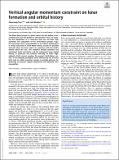Vertical angular momentum constraint on lunar formation and orbital history
Author(s)
Tian, ZhenLiang; Wisdom, Jack
DownloadPublished version (1.286Mb)
Publisher Policy
Publisher Policy
Article is made available in accordance with the publisher's policy and may be subject to US copyright law. Please refer to the publisher's site for terms of use.
Terms of use
Metadata
Show full item recordAbstract
© 2020 National Academy of Sciences. All rights reserved. The Moon likely formed in a giant impact that left behind a fastrotating Earth, but the details are still uncertain. Here, we examine the implications of a constraint that has not been fully exploited: The component of the Earth-Moon system's angular momentum that is perpendicular to the Earth's orbital plane is nearly conserved in Earth-Moon history, except for possible intervals when the lunar orbit is in resonance with the Earth's motion about the Sun. This condition sharply constrains the postimpact Earth orientation and the subsequent lunar orbital history. In particular, the scenario involving an initial highobliquity Earth cannot produce the present Earth-Moon system. A low-obliquity postimpact Earth followed by the evection limit cycle in orbital evolution remains a possible pathway for producing the present angular momentum and observed lunar composition.
Date issued
2020Department
Massachusetts Institute of Technology. Department of Earth, Atmospheric, and Planetary SciencesJournal
Proceedings of the National Academy of Sciences of the United States of America
Publisher
Proceedings of the National Academy of Sciences